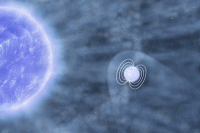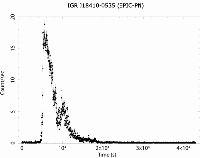Neutron star caught feasting on clump of stellar matter
28 June 2011
With a stroke of luck, astronomers using ESA's XMM-Newton X-ray observatory have observed a neutron star in a peculiar X-ray binary system undergoing an extremely rare, intense flare. This outburst of X-rays, which lasted about four hours, was due to a sudden increase in the rate at which the neutron star was accreting matter from its companion, a blue supergiant star. By monitoring this phenomenon in unprecedented detail, the data provide the first, substantive evidence to explain such luminosity variations in this type of binary system; the flare appears to be due to the ingestion of a massive clump of matter by the neutron star.
 |
|
Artist's impression of a neutron star devouring a massive clump of matter. |
"To investigate these huge luminosity variations we need to observe SFXTs during a flare, but this has proven to be extremely hard due to the rarity and unpredictability of such events," explains Enrico Bozzo from the ISDC Data Centre for Astrophysics at the University of Geneva, Switzerland. A team led by Bozzo planned to study one particular object, the binary system IGR J18410-0535, which had been observed to flare on more than one occasion over the past few years. However, given the extremely rare occurrence of such events, which happen at most a few times per year, the main goal of the observations was to probe the system in its normal quiescent state. "Imagine then our surprise when we realised that we had caught the source while it was flaring," he adds.
Expecting it to be rather faint, as SFXTs are most of the time, the team had secured a long observation of the source with ESA's X-ray observatory, XMM-Newton, in order to probe its properties in detail. There was no indication whatsoever that an outburst would take place during their scheduled observations. "Our discovery was a truly lucky one, and not only because XMM-Newton happened to be looking at this object during the flare," notes Bozzo. In fact, the planned observation was also, by good fortune, of the right duration. The source was observed for 12.5 hours, enabling the astronomers to record the entire extent of the flare, which lasted about 4 hours, as well as to follow the source for a few hours after it returned to its normal, dormant state. As a result of this fortuitous circumstance, Bozzo and his colleagues were able to study the event in great detail and to infer the underlying cause for the rare and powerful flares.
 |
|
The light curve of the Supergiant Fast X-ray Transient IGR J18410-0535 as observed by XMM-Newton. Credit: From Bozzo et al., A&A, 2011 |
It is well known that, in the case of SFXTs, the neutron star does not accrete matter through a disc, because the wind flowing out of the companion is too diffuse and fast to form one. Instead, matter is transferred directly from the wind, 'raining' onto the neutron star from virtually all directions and then being funnelled by the magnetic field lines towards its poles. The matter accretion process releases X-rays, and any abrupt outburst of this radiation, such as the detected flare, must have something to do with changes in the accretion rate.
"We are confident that we have witnessed the neutron star ingesting a clump of matter, a much denser patch of the stellar wind that typically feeds it," Bozzo explains. Under the crude assumption that the clump has a spherical shape, the astronomers have estimated its mass and radius. The clump's mass, of the order of 1019 kg, turns out to be equivalent to one thousandth of the Moon's mass, whereas its radius, of about 8 million km, is 4000 times larger than that of our planet's natural satellite.
On the theoretical front, a clumpy wind generated by the blue supergiant and intermittently enhancing the amount of matter accreted by the neutron star is one of the main scenarios invoked to account for the intense flares that distinguish SFXTs from ordinary supergiant X-ray binaries. The data collected by Bozzo and colleagues represent, for first time, solid evidence in support of this model. A detailed analysis of the source's spectrum during the entire observation has allowed them to measure by how much the radiation emitted by the neutron star is absorbed by the surrounding medium as a function of time. The inferred absorption displays a peculiar trend, which is fully consistent with a massive clump that approaches and engulfs the neutron star, obscuring it for a while, and then moves away or dissolves.
Another piece of evidence in favour of the clumpy wind accretion picture is the detection of an iron emission line at about 6.4 keV. This line arises when photons are reflected off iron ions in the region around the neutron star, and its presence here indicates how the X-ray photons produced during the flare have ionised the clump material and the surrounding medium. It was decisive, in order to reveal this weak but crucial line, that the source was observed over a relatively long interval in the phase following the flare.
"This is a remarkable result triggered by a serendipitous discovery that, at the same time, highlights XMM-Newton's unique capabilities," comments Norbert Schartel, XMM-Newton Project Scientist. "Thanks to its large effective area, the telescope is sensitive enough to pin down the temporal evolution of the source's absorption, before and after the flare, as well as the iron line. Both measurements indicate that these flares can be linked to the neutron star ingesting a clump of matter."
It is unlikely that a similar discovery will be repeated in the near future, due to the scarce and random occurrence of such events. Nevertheless, the team still plan to monitor more SFXTs with XMM-Newton, mostly to study the quiescent phase of this class of object and characterise them in greater detail. With any luck, they could even spot another flare and improve our current understanding of these bizarre phenomena.
Notes for editors
The source observed in this study, IGR J18410-0535, was discovered with JAXA's Advanced Satellite for Cosmology and Astrophysics (ASCA), in 2001. The study described here is based on observations performed with ESA's XMM-Newton, starting on 15 March 2010 and lasting for about 45 000 seconds - equivalent to 12.5 hours.
The observations were performed using all three cameras on board XMM-Newton: EPIC-PN, EPIC-MOS1 and EPIC-MOS2. The observations have been performed in the energy range 0.15-15 keV for the EPIC-PN camera and in the energy range 0.3-12 keV for the two EPIC-MOS cameras.
The subclass of Supergiant Fast X-Ray Transients (SFXT), belonging to the broader class of supergiant X-ray binaries, was discovered with ESA's INTEGRAL gamma-ray observatory in 2005. A few supergiant X-ray binaries had been observed to undergo flares in the past with other observatories; INTEGRAL's contribution was decisive in collecting a wide sample of such sources and establishing that they all display repeated outbursts and with very similar characteristics, thus indicating that they represent a new class of sources.
Related publications
Bozzo, E., et al., "XMM-Newton observations of IGR J18410-0535: the ingestion of a clump by a supergiant fast X-ray transient", A&A, 531, A130 (2011), DOI: 10.1051/0004-6361/201116726
Contacts
Enrico Bozzo
ISDC, Data Centre for Astrophysics
University of Geneva
Switzerland
Email: enrico.bozzo unige.ch
unige.ch
Phone: +41 793129209
Norbert Schartel
ESA XMM-Newton Project Scientist
Directorate of Science and Robotic Exploration
European Space Agency
Email: Norbert.Schartel esa.int
esa.int
Phone: +34 91 8131 184

